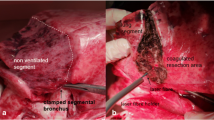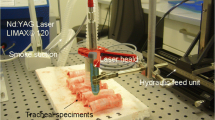Abstract
Lung metastases in healthy patients should be removed non-anatomically whenever possible. This can be done with a laser. Lung parenchyma can be cut very well, because of its high energy absorption at a wavelength of 1940 nm. A coagulation layer is created on the resected surface. It is not clear, whether this surface also needs to be sutured to ensure that it remains airtight even at higher ventilation pressures. It would be helpful, if suturing could be avoided, because the lung can become too puckered, especially with multiple resections, resulting in considerable restriction. We carried out our experiments on isolated and ventilated paracardiac lung lobes of pigs. Non-anatomic resection was carried out reproducibly using three different thulium laser fibres (230, 365 and 600 μm) at two different laser power levels (10 W, 30 W) and three different resection depths (0.5, 1.0 and 2.0 cm). Initial airtightness was investigated while ventilating at normal frequency. We also investigated the bursting pressures of the resected areas by increasing the inspiratory pressure. When 230- and 365-μm fibres were used with a power of 10 W, 70 % of samples were initially airtight up to a resection depth of 1 cm. This rate fell at depths of up to 2 cm. All resected surfaces remained airtight during ventilation when 600-μm fibres were used at both laser power levels (10 and 30 W). The bursting pressures achieved with 600-μm fibres were higher than with the other fibres used: 0.5 cm, 41.6 ± 3.2 mbar; 1 cm, 38.2 ± 2.5 mbar; 2 cm, 33.7 ± 4.8 mbar. As laser power and thickness of laser fibre increased, so the coagulation zone became thicker. With a 600-μm fibre, it measured 145.0 ± 8.2 μm with 10 W power and 315.5 ± 6.4 μm with 30 W power. Closure with sutures after non-anatomic resection of lung parenchyma is not necessary when a thulium laser is used provided a 600-μm fibre and adequate laser power (30 W) are employed. At deeper resection levels, the risk of cutting small segmental bronchi is considerably increased. They must always be closed with sutures.




Similar content being viewed by others
References
Osei-Agyemang T et al (2013) Pulmonary metastasectomy: an analysis of technical and oncological outcomes in 301 patients with a focus on laser resection. Zentralbl Chir 138(Suppl 1):S45–S51
Rolle A, Kozlowski M (2005) Laser resection of lung parenchyma—a new technical and clinical approach. Rocz Akad Med Bialymst 50:193–196
Vodicka J et al (2014) Pulmonary metastases—12-year experience with surgical therapy. Rozhl Chir 93(4):194–201
Venuta F et al (2010) Techniques used in lung metastasectomy. J Thorac Oncol 5(6 Suppl 2):S145–S150
Yan H et al (2013) Thulium laser vaporesection versus standard transurethral resection of the prostate: a randomized trial with transpulmonary thermodilution hemodynamic monitoring. Int J Urol 20(5):507–512
Aho TF, Gilling PJ (2008) Current techniques for laser prostatectomy—PVP and HoLEP. Arch Esp Urol 61(9):1005–1013
Bach T et al (2009) Thulium:yttrium-aluminium-garnet laser prostatectomy in men with refractory urinary retention. BJU Int 104(3):361–364
Bilici T et al (2011) Development of a thulium (Tm:YAP) laser system for brain tissue ablation. Lasers Med Sci 26(5):699–706
Burns JA et al (2007) Thermal damage during thulium laser dissection of laryngeal soft tissue is reduced with air cooling: ex vivo calf model study. Ann Otol Rhinol Laryngol 116(11):853–857
Calisto A et al (2014) Endoscopic disconnection of hypothalamic hamartomas: safety and feasibility of robot-assisted, thulium laser-based procedures. J Neurosurg Pediatr 14(6):563–572
Kamalski DM et al (2014) A nonrandomized comparison of the thulium laser and the CO2 laser in primary stapedotomy for otosclerosis. Otol Neurotol 35(10):1715–1719
Macchiarini P et al (1999) Experimental and clinical evaluation of a new synthetic, absorbable sealant to reduce air leaks in thoracic operations. J Thorac Cardiovasc Surg 117(4):751–758
Marulli G et al (2013) A prospective randomized trial comparing stapler and laser techniques for interlobar fissure completion during pulmonary lobectomy. Lasers Med Sci 28(2):505–511
Tansley P et al (2006) A prospective, randomized, controlled trial of the effectiveness of BioGlue in treating alveolar air leaks. J Thorac Cardiovasc Surg 132(1):105–112
Kirschbaum A et al (2012) Local effects of high-powered neodymium-doped yttrium aluminium garnet laser systems on the pulmonary parenchyma: an experimental study on the isolated perfused pig lung lobe. Interact Cardiovasc Thorac Surg 15(2):191–193
Kirschbaum A et al (2014) Airtightness of lung parenchyma without a closing suture after atypical resection using the Nd:YAG Laser LIMAX 120. Interact Cardiovasc Thorac Surg 18(1):92–95
Author information
Authors and Affiliations
Corresponding author
Rights and permissions
About this article
Cite this article
Kirschbaum, A., Höchsmann, N., Steinfeldt, T. et al. Investigations of initial airtightness after non-anatomic resection of lung parenchyma using a thulium-doped laser with different optical fibres. Lasers Med Sci 31, 1097–1103 (2016). https://doi.org/10.1007/s10103-016-1952-5
Received:
Accepted:
Published:
Issue Date:
DOI: https://doi.org/10.1007/s10103-016-1952-5




